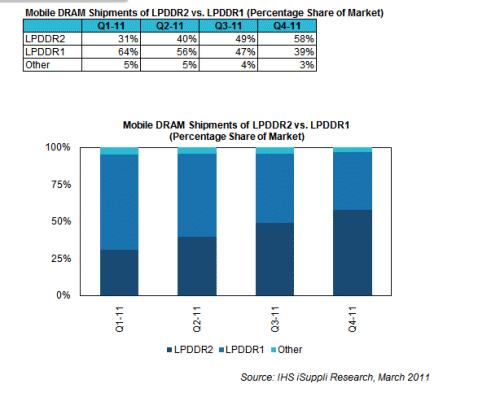Alternative Technologies Vie for Share of Fast-Growing Mobile DRAM Market
El Segundo, Calif., March 30, 2011—Mobile dynamic access random memory (DRAM) in its current form soon may prove inadequate for the data intensive needs of smart phones and tablets in handling applications, but emerging options await in the wings as possible replacements in mobile platforms, according to new IHS iSuppli research.
Low-power, double data rate 2 (LPDDR2) is just now becoming the predominant technology in the mobile DRAM space, projected to take 40 percent market share by the second quarter this year, up from 31 percent in the first quarter. The majority of the mobile DRAM market continues to be held by the older LPDDR1 technology—although not for long.
By the fourth quarter this year, the tables will have turned, with LLPDDR2 finally gaining ascendance for the first time and controlling 58 percent of the market, as shown in the figure below.

“Once a sleepy backwater of the DRAM market, mobile DRAM now is getting considerably more engineering and development attention from important players like Samsung Electronics Co., Hynix Semiconductor Inc., Elpida Memory Inc. and Micron Technology,” said Mike Howard, principal analyst for DRAM and memory at IHS. “Unlike standard DRAM, the mobile counterpart for memory uses reduced power, generates a smaller amount of heat and takes up less space—attributes especially suitable for smart phones and other small electronic devices, with their need for greater computing power but possessing limited real estate. Mobile DRAM also is used in digital still cameras, portable media players, portable gaming products and tablets.”
A major challenge to mobile DRAM is its performance for future devices. While LPDDR2 is adequate now for phones and tablets, power consumption and bandwidth remain areas of concern.
For instance, operating at 1.2V, LPDDR2 offers as much as 50 percent power savings per data transfer compared to LPDDR1. However, if the devices of tomorrow perform 10 times as many data transfers—well within conceivable attainment soon—LPDDR2 would come up woefully short.
LPDDR2’s transfer rate of 8.5 gigabytes (GB) per second is also phenomenal compared to 1066 megahertz (MHz) for LPDDR1, but the LPDDR2 rate might not be enough for devices making their debut in the very near future. Feedback from smart phone makers has pointed to the need for rates of 12.8GB per second, which would necessitate LPDDR2 increasing its clock rate to 800MHz. This does not appear feasible, IHS believes.
What’s next in the pipeline?
With the performance thresholds of LPDDR2 likely to be reached and exhausted soon, several mobile DRAM technologies are vying for attention as alternatives. The competing technologies are shown in the attached table.
The current front runners are mobile XDR, offered by Rambus Inc.; and Serial Port Memory Technology (SPMT), developed by the SPMT Consortium and designed to be a royalty-free memory interface.
Other competitive mobile DRAM technologies include Wide I/O, which promises to connect DRAM cores at the silicon level but is not necessarily a mobile technology; LPDDR3, whose specifications remain undefined; and DDR4, a form of standard DRAM not likely to appear until 2013.
Learn more about the latest developments in the DRAM market with the IHS brief entitled: The Coming Challenges for Mobile DRAM.
Advertisement
Learn more about IHS iSuppli





